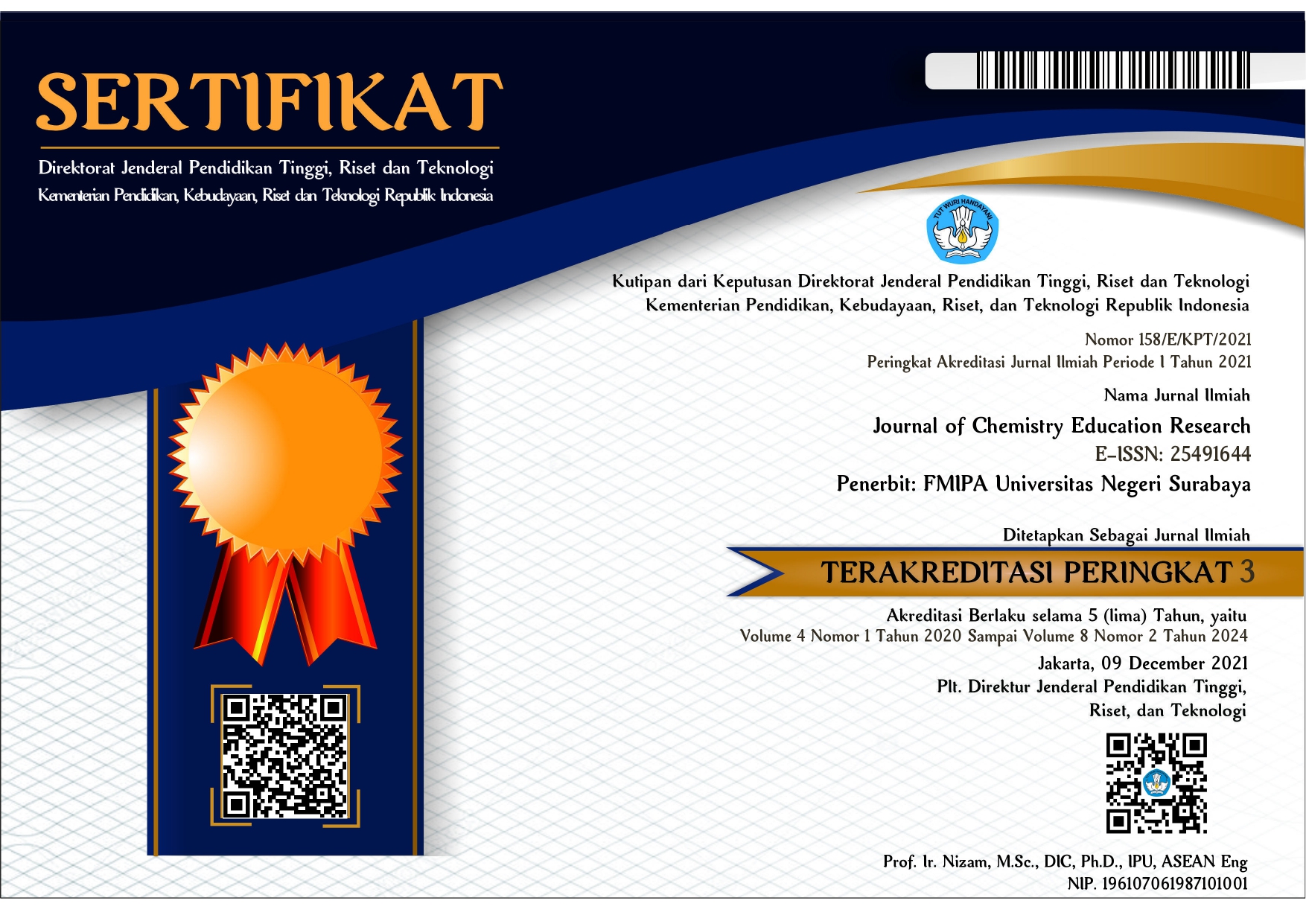ANALYSIS INHIBITING FACTOR OF STUDENTS COMMUNICATION SKILL THROUGH IMPLEMENTATION OF NHT ON COLLOID MATERIAL
DOI:
https://doi.org/10.26740/jcer.v1n2.p48-55Keywords:
numbered head together (nht), factors inhibiting communication, colloidAbstract
This study was aimed to know the inhibiting factor of student communication skill in colloid material with application of Numbered Head Together model. The method of this research is descriptive quantitative and target are student of class XI IPA 2 SMAN Wonoayu Sidoarjo and XI IPA 5 SMA Al-Islam Krian with amount of 39 and 45 students. Result of this researchwas found that 41.03% of students of IPA 2 SMAN Wonoayu and 42.2% of students of XI IPA 5 SMA AL Islam Krian included communication delay. The results of data analysis showed that in XI IPA 2 SMAN Wonoayu Sidoarjo as much as 75% of student experience communication delays on ecological and psychological factors; 43.7% by the messaging and semantic factors. While in XI IPA 5 SMA Al Islam Krian 73.7% by psychological factors; 68% by ecological factors; 47.4% by messenger factors, and 42.1% by receiver and semantic factors.References
[1] Abedini, M., Abassi, A., Mortazavi, F., & Bijari, B. (2013). The effective factors on the communication between students and faculty members from students prospective in Birjand University of Medical Science,Elsevier, h. 94-98.
[2] Depdiknas. (2013).Peraturan Mentri Pendidikan Dan Kebudayaan Nomor 69Tahun 2013 Tentang Kerangka Dasar Dan Struktur Kurikulum Sekolah Menengah Atas/Madrasah Aliyah. Jakarta: Badan Standar Nasional Pendidikan.
[3] Duta, N. (2015). From theory to practice: the Barriers to Efficient Communication in Teacher-student Relationship,Elsevier-Sosial and Behavioral Science. h. 625-630.
[4] Effendy, O. U. (2000).Dinamika Komunikasi. Bandung: PT. Remaja Rosdakarya.
[5] Hutagalung, I. (2017).Pengembangan Kepribadian. Jakarta: INDEKS.
[6] Ibrahim, M. (2000). Pembelajaran Kooperatif. Surabaya: University Press.
[7] Luneberg, F. (2010). Communication: The Process, Barriers, adan Improving Effectiveness,Schooling. h. 1-11.
[8] Maryansti, S., Zikra, & Nurfarhanah. (2012). Hubungan antara Keterampilan Komunikasi dengan Aktivitas Belajar Siswa,E-Jounal UNP. h. 1-8.
[9] Nursalim, M. D. (2007).Psikologi Pendidikan. Surabaya: Unesa University Press.
[10] Rahayu, E. L. (2013). Penggunaan Media Presentasi Powerpoint Untuk Meningkatkan Keterampilan Berkomunikasi Belajar IPS pada Siswa Kelas VII A SMP Negeri 4 Kalasan Tahun Ajaran 2012/2013,Lumbung Pustaka UNY. h.10-11.
[11] Riduwan. (2015). Dasar-Dasar Statistika, Bandung: Allfabeta.
[12] Syah, M. (2003). Psikologi Belajar. Jakarta: PT. Raja Grafindo Persada.
[13] Tay, L. H., Hegney, D., & Ang, E. (2011). Factors affecting effective communication between registered nurses and adult cancer patients in an inpatient setting: a systematic review,International Journal of Evidence-Based Healthcare. h. 151-164.
[14] Tiana, W. A., & Muchlis. (2016). Penerapan Model Pembelajaran Kooperatif Tipe NHT pada Materi Asam Basa untuk Melatihkan Keterampilan Komunikasi Kelas XI SMA Negeri 1 Boyolangu Tulungagung, Journal of Chemical Education. h.553-562.
Downloads
Published
Issue
Section
 Abstract views: 299
,
Abstract views: 299
, PDF Downloads: 304
PDF Downloads: 304



